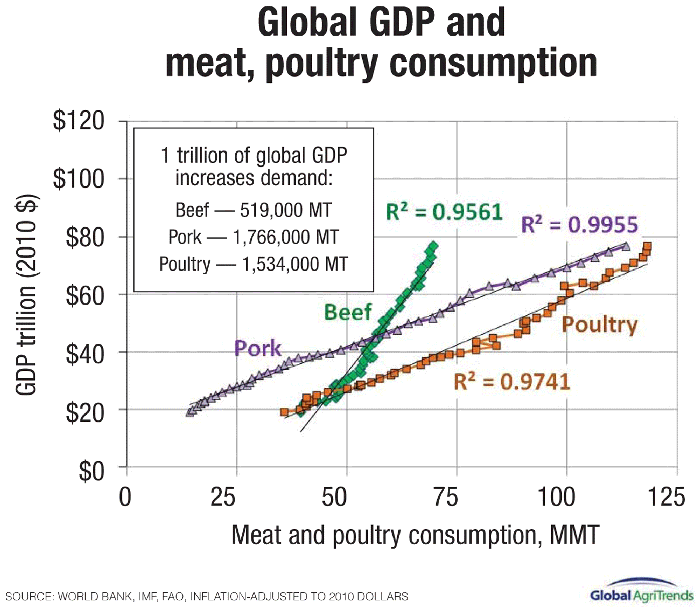The global market for pork is somewhat of a tangled web of import protocols, regulations, culture and economics — unfortunately, often in that order. What is the future for U.S. pork in the global markets?

U.S. pork is not the largest global producer or exporter. But with $6.2 billion in exports last year, the industry is globally significant. Competitive production and pricing make U.S. pork affordable all over the world. Global consumers eat more than one-fifth of U.S. pork production. But the global market for pork is somewhat of a tangled web of import protocols, regulations, culture and economics — unfortunately, often in that order. What is the future for U.S. pork in the global markets? Let’s take a look.
Success in global markets requires a few key factors. First, the product must be safe, humanely raised and affordable. Next, logistics must exist to move a highly perishable, sensitive product across oceans and continents, as well as a “cold chain” at the end of the ride to get this product to consumers.
Market access must be negotiated to allow entry into foreign markets without undue burdens of regulations, duties and non-standardized sanitary requirements.
And finally, the product must be demanded by the ultimate consumer, a step involving marketing, education and other promotional efforts.
Global pork trade is a complicated business requiring a vast team of professionals from varying fields, with skills ranging from logistics to pathogen control to microbiological and consumer research.
And a pig is not just a pig. It is not a single SKU, but a bundle of many SKUs. We may think of pork chops, loins and hams for meals, but consumers in China treasure pig feet, intestines, ears, tails and snouts. Global consumers also enjoy a wide variety of processed pork products.
Global competitors abound. On a global basis, pork is much more standardized in quality, taste and flavor profile than beef, which varies widely by genetics and production system. I have seen top-notch hog farms producing high-quality pork on five continents.
Note that genetics, feed, technology and equipment are all globally mobile. An example is Chile.
In the early 1990s, Chile’s pork was a small backyard industry with limited feed grains. Investors planned, dreamed and imported technology, genetics, equipment, and feed, and built a world-class pork production base for exporting pork all over the world.
My work is focused on analysis, research and forecasting of the global protein markets. I have seen pigs and eaten pork all over the world. I track global hog and feed prices weekly. I have global commodity data sets exceeding 50 years and speak with global contacts weekly. This gives me a unique view to put the U.S. pork industry into a global perspective.
U.S. the low-cost leader
Week in, week out, U.S. pork is typically the most affordable pork on the planet, based on hog prices. While China holds more than half of the world’s hogs and is the world’s “low-cost” manufacturer of many consumer products, they are nearly always higher-cost hog producers than the United States.
Think of it this way: U.S. agriculture is generally the “China” of the agriculture world. We are typically the low-cost producer of corn, wheat, pork, poultry, beef, rice and soybeans — but particularly in pork.
This significant cost advantage suggests that U.S. pork should dominate markets everywhere. But these markets are more complex than that. Various cuts trade at various prices in various cultures.
The meat case in a Walmart in Nanning, China, last year showed pork loins at 16.8 rmb per 500 g (US$2.25 per pound) next to pig feet at 23 rmb per 500 g ($3.07 per pound) and trimmed rib bones at 31.8 rmb per 500 g ($4.25 per pound).
There are major cultural variances in demand for various cuts. Another example is the strong U.S. demand for pork bellies (bacon) and ribs. Cultures and customs shape consumer demand.
An actual hindrance to being the low-cost supplier is just that: The fact that U.S. pork can undercut domestic prices. It works fine for consumers, but what about foreign producers?
Farmers are strategically important in any country and, thus, politically protected. Affordable U.S. pork is a threat to countries seeking to maintain self-sufficiency goals. And this “trade policy” arena is where it gets complicated.
Note the difference between the U.S. and Chinese hog prices in the chart “Global hog prices.” This would suggest a giant sucking sound of U.S. pork to China. But looking at this chart, that scenario rarely happens. U.S. pork accounted for 0.3% of Chinese consumption (and 1.5% of U.S. production) last year.
What about China?
The chart “China’s pork imports” shows the country’s monthly pork imports, both from the U.S. and other sources. Note the volatility around Chinese price cycles. Each of the “spikes” in imports revolved around high Chinese prices, either from disease-driven shortages, or high corn prices driving sow liquidation.
When China needs pork, China buys pork. Unfortunately, the inverse is somewhat true also. And note the big run-up in non-U.S. pork during the last price cycle. Most of this was EU pork.
U.S. pork has been restricted based on China’s non-scientific requirements over residues of ractopamine. The non-scientific part of that restriction is a zero-tolerance for residues that go beyond global and U.S. standards.
But don’t get hung up on details. China has long “managed” U.S. pork imports through some means, including plant de-listings, inspection delays (happening now) and other measures. The bottom line is that the U.S. and China have a complex, co-dependent, bipolar, political and commercial relationship. And both sides jockey for power.
China is holding to self-sufficiency rates above 95% in pork, but the market is massive and diverse. The $8 billion pork import market (including China and Hong Kong) is basically a niche market, serving only 5% of total pork consumption.
U.S. opportunities in China necessitate patience and continued pressure toward global standards, as well as continued market development.
Free-trade agreements have been secured allowing duty-free pork into Australia, Canada, Chile, Colombia, Hong Kong, Mexico and South Korea. The chart above, “U.S. port exports,” shows pork exports to these duty-free nations versus all others. Note the growth in exports to the duty-free markets. There are also duty-free quotas for the Central America Free Trade Agreement and other FTA nations; most quotas end in 2020-21.
The FTA game
China has a goal of 10 new free-trade agreements in 2018, with studies commencing on 10 additional ones. Australia now reports that over 60% of its national exports are under an FTA; it reports plans to reach 80% by 2020.
The last major U.S. FTA was with Korea, completed in 2008, altered and then implemented in 2012. The agreement now gives the U.S. the only duty-free pork access into the country, an enviable spot. The Korea-EU FTA will provide duty-free pork access in 2021 for bellies (its most-traded item to Korea); Canada gets duty-free pork to Korea in 2019.
Outside of the Trans-Pacific Partnership agreement — now the Comprehensive and Progressive Agreement for Trans-Pacific Partnership — the U.S. has not negotiated an FTA since 2012 (Korea, Colombia and Panama). Key competitors are cutting deals around us.
Chile and Mexico have preferential access for pork into Japan, the No. 1 U.S. pork export market by value. And possibly by next year, the 11 CPTPP nations (including Canada and Chile) and the EU will have the same access to Japan, leaving the U.S. as the odd-man out for our most lucrative pork export destination.
China announced it will seek 10 new FTAs this year and initiate studies into another 10. Australia now reports that over 60% of its national exports are under FTAs, with a goal of 80% by 2025.
President Donald Trump pledged to seek better bilateral agreements, even as he withdrew the U.S. from the TPP agreement. But those have yet to occur. Time is of the essence; FTAs take years to complete and often include years of tariff phasedowns. What we sow now may take a decade to reap.
Where is the future?
Perhaps the most troubling trade situations include the lack of accountability by China to global scientific standards, and Japan making agreements with our competitors. Those are tough issues with no clear solution, at least in the short term. But there are other opportunities for growth.
Mexico remains an incredible market for U.S. pork, averaging 13% annual growth for the past 10 years (now triple the 2007 volumes). But there is a limit to how much pork Mexico will buy. The U.S. poultry industry hit that “glass ceiling” three years ago in Mexico and is now seeing smaller annual shipments south due to Mexico’s domestic poultry expansion. So Mexico is a great market for a time, but there are likely limits.
I am often asked, “Where is our next export growth opportunity?” The question is simple, the answer more complex.
I see the next significant growth opportunity to be a basket of markets, not one single market. With our new duty-free access to Colombia, Chile and Central American nations (CAFTA and the Dominican Republic), we will be a strong force in those markets. Colombia has a population similar to Korea; the CAFTA-DR group is nearly that size (40 million).
And there are other regions of the world seeking more pork. EU and Brazil sent a combined US$374 million in pork to Africa last year (307,000 metric tons). The U.S. sent US$2.6 million.
But a new agreement with South Africa is beneficial, as would be a potential agreement with Nigeria (population 186 million), hinted to by Nigerian President Buhari in meetings with Trump on April 30.
Granted, Africa is a unique market, but remember that U.S. pork prices (think hams and offal) are competitive globally.
These and other markets hold the key to U.S. export growth. And the U.S. is well-poised to capitalize on new opportunities. The U.S. Meat Export Federation has a global presence, with staff tracking consumer trends, competitor prices and market access globally.
Protein demand
If we look from the 40,000-foot level at global pork demand, the chart below shows the correlation between global GDP (economic output or total global income) and meat and poultry consumption.

The flatter slopes of the pork and poultry lines suggest that they are very elastic. Said another way: Rising global GDP is like rocket fuel for demand. Forecasts by the International Monetary Fund suggest that global GDP growth will average $2.7 trillion annually out to 2030. Continuing that correlation calculates to 4.7 million metric tons more global pork needed annually. For reference, that is about 40% of U.S. production last year.
I don’t think global supplies can grow fast enough to supply these levels of demand; the model may shift as a result. But global demand appears strong over the next decade.
Too much pork?
The point I’ll address is, “Are we producing too much pork?”
That’s an easy question to answer because a free market sends very clear and direct signals regarding our output.
The textbook definition of consumer demand is “a consumer willingness to pay at a specified level of production.”
And based on per-capita U.S. supplies nearing the highest levels in 19 years (based on my 2018 forecasts), I’d say the market has been mostly fine with current levels.
But the continued expansion in 2019 takes per-capita supplies to the highest levels since 1981 (37 years). Adding in beef and poultry supplies takes my U.S. per-capita supply number to a record 205 pounds in 2019, up 21 pounds in five years.
That level feels “heavy” to me. Big investment in U.S. hog production and packing infrastructure by some bold souls will be needed in coming years.
The question is how fast do we build and fill these plants with hogs. I would suggest that with rising beef and poultry supplies, caution is warranted.
Bottom line
U.S. pork is the typically the most competitive on earth. Global populations are rising by 78 million per year. Global incomes are rising and will pull nearly 3 billion into the global middle class (2009 to 2030). Demand is rising but not in a straight line.
U.S. producers can overproduce. There will be a lot of ups and downs on the broad global demand growth trendline. But in the end, the future belongs to those who can adapt, and I would add, to those who can gain the best market access.
About the Author(s)
You May Also Like





